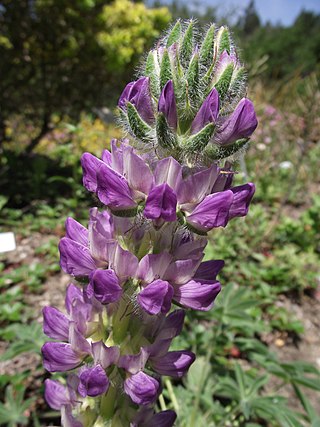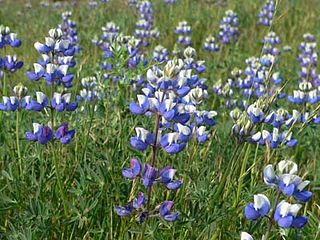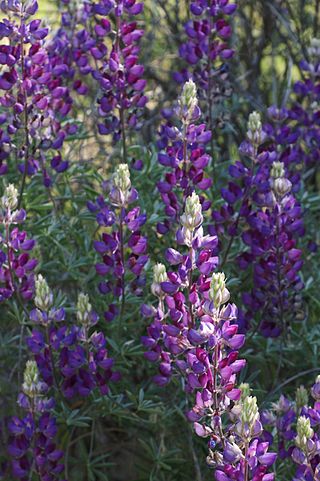
Lupinus, commonly known as lupin, lupine, or regionally bluebonnet etc., is a genus of plants in the legume family Fabaceae. The genus includes over 199 species, with centers of diversity in North and South America. Smaller centers occur in North Africa and the Mediterranean. They are widely cultivated, both as a food source and as ornamental plants, but are invasive to some areas.

Lupinus diffusus, commonly known as Oak Ridge lupine, spreading lupine, or sky-blue lupine, is a species of lupine native to the southeastern United States, from North Carolina south to Florida and west to Mississippi. It is restricted to very dry, sandy soils, often in open pine or oak woodlands.

Lupinus arizonicus, the Arizona lupine, is a flowering plant in the legume family Fabaceae, native to the Mojave and Sonoran Deserts of North America, where it can be found growing in open places and sandy washes below 1,100 metres (3,600 ft) elevation. It is common around Joshua Tree National Park and Death Valley National Park in California.

Lupinus microcarpus, the wide-bannered lupine or chick lupine, is a species of lupine native to western North America from southwestern British Columbia south through Oregon and California, including the Mojave Desert, and into Baja California. There is also a disjunct population in South America, with locations in central Chile and western Argentina.

Lupinus texensis, the Texas bluebonnet or Texas lupine is a species of lupine found in Texas, Louisiana, Arkansas and the Mexican states of Coahuila, Nuevo León, and Tamaulipas. With other related species of lupines also called bluebonnets, it is the state flower of Texas.

Lupinus nanus, the sky lupine, field lupine, dwarf lupin, ocean-blue lupine or Douglas' annual lupine, is a species of lupine native to the western United States. It is found natively in California, Nevada, and on Steens Mountain in eastern Oregon. It tends to grow on slopes and in open or disturbed areas below 1300 meters.

Lupinus perennis is a flowering plant in the family Fabaceae.
Lupinus latifolius var. barbatus, the Klamath lupine, sometimes also called bearded lupine, is a very rare plant of the Western U.S., known only from northeastern California and southeastern Oregon. It is a rare variety of the generally common species L. latifolius, which is a member of the bean family.

Lupinus excubitus is a species of lupine known as the grape soda lupine. Its common name refers to its sweet scent, which is said to be very reminiscent of grape soda. This species and its variants are found in Southwestern United States, especially in California and Nevada, e.g., Death Valley and Joshua Tree National Parks, and northwestern Mexico.

Lupinus albifrons, silver lupine, white-leaf bush lupine, or evergreen lupine, is a species of lupine (lupin). It is native to California and Oregon, where it grows along the coast and in dry and open meadows, prairies and forest clearings. It is a member of several plant communities, including coastal sage scrub, chaparral, northern coastal scrub, foothill woodland, and yellow pine forest.
Lupinus andersonii is a species of lupine known by the common name Anderson's lupine.

Lupinus brevicaulis is a species of lupine known by the common names shortstem lupine and sand lupine. It is native to the southwestern United States, including Oregon, California, Nevada, Utah, Colorado, Arizona, and New Mexico, where it grows in many types of sandy habitat.

Lupinus cervinus is a species of lupine known by the common name Santa Lucia lupine. It is endemic to the Santa Lucia Mountains in the Central Coast Ranges in California, where it is an uncommon member of the flora in the mountain forests. This is a hairy gray-green perennial herb growing up to 30–70 centimetres (12–28 in) tall. The erect stem is surrounded by clusters of spreading leaves. Each palmate leaf is made up of 4 to 8 leaflets up to 8 centimetres (3.1 in) long and 3 centimetres (1.2 in) wide, which is wider than the leaflets of most lupines. The inflorescence bears many flowers, sometimes in whorls, each between 1 centimetre (0.39 in) and 2 centimetres (0.79 in) long. The flower is often bright pink, but may be shades of blue to nearly white. There is often a yellow patch on the banner. The fruit is a hairy legume pod up to 6 centimetres (2.4 in) long.
Lupinus hyacinthinus is a species of lupine known by the common name San Jacinto lupine. It is native to the mountains of southern California and adjacent Baja California, where it grows in dry areas, often in pine forests.
Lupinus saxosus is a species of lupine known by the common name rock lupine. It is certainly native to eastern Washington, eastern Oregon, and the northeast corner of California,where it grows in sagebrush and other habitat. It may also be native to Idaho and Nevada.

Lupinus arcticus is a species of flowering plant in the legume family known by the common names Arctic lupine or subalpine lupine. It is native to northwestern North America, where it occurs from Oregon north to Alaska and east to Nunavut. It is a common wildflower in British Columbia.
Lupinus garfieldensis, commonly known as the Garfield lupine or the Asotin Silky lupine, is a species of lupine native to eastern Washington state.
Lupinus prunophilus, commonly known as the hairy bigleaf lupine or chokecherry lupin, is a medium-sized herbaceous plant that grows in the Great Basin and other parts of the U.S. interior between the Sierra-Nevada and the Rockies. It is a close relative and very similar to Lupinus polyphyllus and is considered a subspecies by some botanists.

Lupinus caudatus is a widespread species of wildflower in genus Lupinus from western North America known by the common names tailcup lupin and spurred lupin. It is distinctive for the short spur on its purple-blue flowers, for which it is named. Because of its wide distribution and toxicity it commonly causes poisonings of susceptible livestock such as horses, cattle, and sheep, though it is eaten without harm by wild herbivores like deer and elk. It is generally found from the Coastal Ranges and Sierra Nevada Mountains in the west to the Rocky Mountains in the east.
Lupinus lemmonii, commonly known as Lemmon's lupine, is a species of perennial plant in the family of Fabaceae that is native to Arizona.













